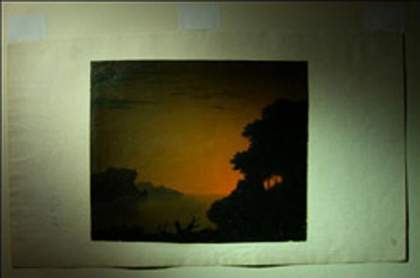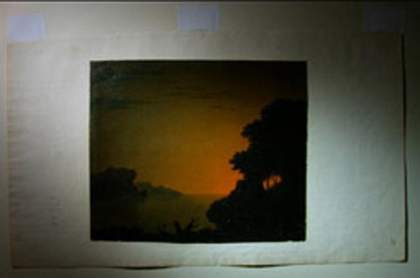
Frank Auerbach
Small Head of E.O.W. (1957–8)
Tate
Background
When a light source is directed at a harsh angle across the face of a painting, any unevenness in the surface structure will cast shadows. Photographing this effect, known as ‘Raking Light Photography’, is a traditional method of documenting the surface structure of painting.
However, this approach will only record the shadows cast by light from one angle at a time and it is difficult and very time-consuming to repeat exactly any given light position during subsequent examinations.
Polynomial Texture Mapping (PTM) is an improved approach being applied to the examination of paintings. This process involves capturing a special set of digital images of a painting lit from various measured angles. These images and the associated light measurements are then combined together within a computer to produce a virtual light map of a painting’s surface.
Now it is possible to achieve this with a digital camera and one light source, by carefully moving and measuring the light position between pictures. However, this can take a long time and requires a lot of patient work.
Equipment
In order to make the process easier The National Gallery produced a prototype imaging dome to facilitate the image capture process and test the technique. This was loaned to Tate for this special imaging treatment.
The dome is composed of a wooden framework with mounting points for 24 lights and a digital camera. This prototype uses diffused 12 v tungsten halogen spot lights wired up to a control box. Each light is angled to point at the floor in the middle of the Dome, and its position is measured relative to the centre of the base of the dome. The colour of each light varies slightly; a white target is captured for each of the lights to facilitate image processing to compensate for this variation.

Alexander Cozens, Scirocco Sunset
Copyright © 2003 National Gallery, London.
All rights reserved

Alexander Cozens, Scirocco Sunset
Copyright © 2003 National Gallery, London.
All rights reserved
Image showing the effects of white balancing on one of the images of Alexander Cozens’s Scirocco Sunset. The original image is displayed on the left and the white balanced image is shown on the right. Once all of the lights have been calibrated in this way, the dome produces a more accurate representation of the artwork.
Capture process
A painting is positioned on the target below the dome, exposure measurements are taken, and a set of 24 images are captured: one image for each of the lights. A second set of 24 images of a white target is also captured; these are used in the calibration process as noted above.
The set of 24 images is then processed on a computer and passed, along with the light measurements, through a program developed by Hewlett-Packard Labs. This program examines how the shadows move across the surface of the painting relative to the position of the lights. It can then calculate which shadows would have been displayed by a light in any position. Thus the finished PTM visualisation gives the viewer the virtual equivalent of taking a light and moving it around across the surface of the painting.
